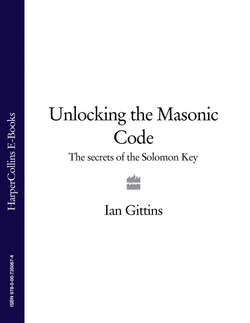Читать книгу Unlocking the Masonic Code: The Secrets of the Solomon Key - Ian Gittins - Страница 24
Masonry gets a Constitutional
ОглавлениеAs part of its drive to reunite and redefine Freemasonry, in 1721 the Grand Lodge of England decided to create a Masonic constitution. It asked one Dr James Anderson, a Scottish nationalist and preacher living in London, to examine old Masonic documents and update them into one instructional manual to be distributed to all lodges as a definitive text.
The result, The Constitution, History, Laws, Charges, Orders, Regulations and Usages of the Right Worshipful Fraternity of Accepted Free Masons, collected from their General Records and their Faithful Traditions of Many Ages, was published in 1723. Also known as the Ancient Charges, or the Book of Constitutions, Anderson’s script remains Freemasonry’s most significant document, and is still read aloud annually in many Masonic lodges around the globe.
Taking its cue from the Regius Manuscript, the Book of Constitutions opens by making outlandish claims about the provenance of Masonry, claiming that not only was Adam the original architect and Noah a Mason, but Moses was a Grand Master! Yet it was the main body of the regulations, headed The Charges of a Free Mason, which was to drop a theological bombshell—and shape Freemasonry for centuries to come.
Until now, Masonry had routinely genuflected before God, with Christian prayers said in lodge meetings and references to the Holy Trinity scattered throughout some rituals. Anderson’s Constitutions abolished such devotions in favour of a nebulous, non-specific deism in the following paragraph:
A Mason is oblig’d by his Tenure, to obey the moral law: and if he rightly understands the Art, he will never be a stupid ATHEIST, nor an irreligious LIBERTINE. But though in ancient Times Masons were charged in every Country to be of the Religion of that Country or Nation, whatever it was, yet it is now thought more expedient only to oblige them to that Religion in which all Men agree, leaving their particular Opinions to themselves; that is, to be good Men and true, or men of Honour and Honesty, by whatever Denominations or Persuasions they may be distinguish’d…
Henceforth, Freemasons would require new Entered Apprentices to pledge their belief in a Greater Being: without such faith, they believed initiates would be unable to undertake the journey of spiritual growth mapped out by the fraternity. But in the new spirit of non-sectarianism, this Supreme Being would take a new name: the Grand Architect of the Universe.
Aside from this radical departure, Anderson’s Constitutions were largely a summation of existing Masonic law. As per the Regius Manuscript, Masons were ordered to be ‘a peaceable subject to the Civil Powers’ and never to plot against king or country. The Charges also emphasized that Freemasonry is inherently democratic: ‘No Master or Warden is chosen by Seniority, but by his Merit’.
Another key Charge stressed the importance of courtesy and consideration amongst Freemasons, and—after a clause warning against excess intake of alcohol—Anderson added a few lines intended to maintain this internal harmony:
‘Therefore no private Piques or Quarrels must be brought within the Door of the Lodge, far less any Quarrels about Religion, or Nations, or State Policy, we being only, as Masons of the Catholick Religion above-mentioned; we are also of all Nations, Tongues, Kindreds and Languages, and are resolved against all Politicks, as what never yet conduc’d to the Welfare of the Lodge, nor ever will.’
These words established the crucial Masonic tenet that religion and politics should never be discussed with the walls of a lodge. It is a stipulation that can be regarded as hugely ironic: the secretive organization that many detractors believe to be a seething mass of dissent and subversion actively legislating against discussing the state of the world.
After the establishment of the Grand Lodge of England and the drafting of the Constitutions, Masonry underwent a period of expansion in England and elsewhere. By 1730, over 100 lodges had pledged allegiance to the Grand Lodge, and 1737 saw the first (publicly admitted, at least) Royal Freemason: Frederick Lewis the Prince of Wales, the son of King George II.
As the British Empire expanded throughout the eighteenth century, Freemasonry made similar territorial quantum leaps. By the end of the century, lodges had been established in Spain, India, South America and even parts of Southeast Asia. As we shall shortly see, however, by far the most significant—indeed, revolutionary—events in international Masonic history were set to play out in the United States and France.
